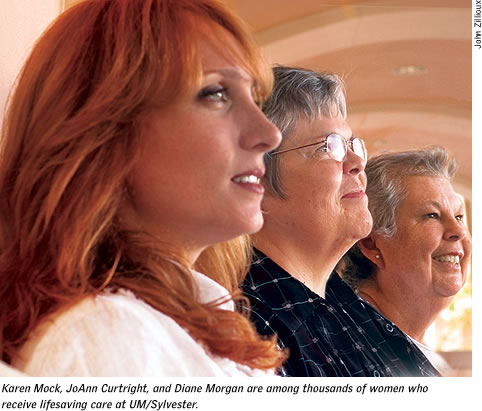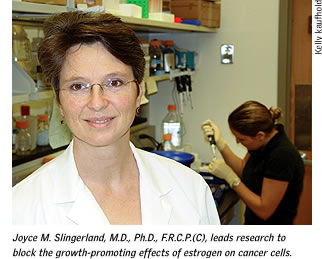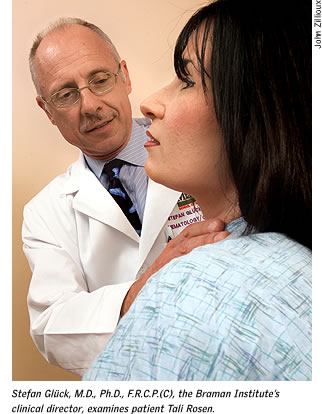
“I hate to tell you this,” the doctor told Diane
Morgan. “But you have cancer.” Morgan’s sister
survived breast cancer nine years ago, as did three childhood
friends. But she lost two cousins to the disease. Now, after
nearly 20 years in Miami, she’s moving back to California’s
wine country to be close to her loved ones. “I figure if
I have health problems I’m going to want to be around family
to back me up.” Morgan is one of more than 600 new breast
cancer patients treated each year at the Braman Family Breast
Cancer Institute at the University of Miami Sylvester Comprehensive
Cancer Center. Her story is unusual—she never felt a lump,
never had a suspicious mammogram—but there was nothing
unusual about being diagnosed with breast cancer. She had 213,000
other people with whom to share her experience. That’s
how many people were diagnosed with breast cancer in the United
States in 2005 alone, including nearly 2,000 men. It would be
daunting enough to try to save nearly a quarter of a million
patients from this disease if it were a single entity. But breast
cancer is an alphabet soup of heterogeneity, as defined by the
tumor’s response to hormones, growth factors, inflammation,
aggressiveness and invasiveness, and the patient’s heredity,
breast density, age, and race.
Over the last quarter-century, advances
in early detection and treatment have greatly improved care,
with physicians from UM/Sylvester setting the pace. Fred
Moffat, M.D., and a team of surgeons have played a pioneering role in the development
of sentinel node biopsy to identify the spread of breast cancer. Judith Hurley,
M.D., who began studying new treatments for locally advanced breast cancers
more than 15 years ago, is an international leader in this
area. Joyce Slingerland,
M.D., Ph.D., F.R.C.P.(C), director of the Braman Family Breast Cancer Institute,
is working to improve ways of blocking the growth-promoting effects of estrogen
on the cancer cell by combining estrogen blockers and new molecular targeted
therapies.
Three Women—Three Different
Stories
Diane Morgan didn’t have breast cancer, she just had a bruise. At least
that’s what she thought until that November day when the phone rang.
“All the air went out of me,” says Morgan. “I was completely
in shock.” She
had been clearing out water that blew into her apartment during Hurricane Katrina
when she slipped on the wet floor and fell on her side, banging her right breast
on a doorknob.
Her primary care doctor just asked whether
she had bumped into something. But a needle biopsy confirmed
the diagnosis—inflammatory breast -cancer.
JoAnn Curtright found her own lump in
2003. “I had been on a diet that
changed my body shape so that’s why I was able to find it. I tell people
the South Beach Diet saved my life.” Curtright’s cancer was fueled
by estrogen.
At the age of 33, Karen Mock felt a suspicious
lump and just knew it was breast cancer—but she couldn’t get anyone to believe her. “I tried
for a year and a half. I kept telling doctor after doctor that I had breast cancer
but they kept saying I was too young,” says Mock.
She’s also the mother of two.
“I finally saw Dr. Dido Franceschi, a breast surgeon at UM/Sylvester. He
opened
my gown, looked at me in shock and said, ‘Listen, you have breast cancer.
Why did you wait so long?’” Mock’s disease was locally invasive,
HER2-neu.
Three women. Three diagnoses. All breast
cancer.
Treatment Strategies
There’s nothing final about a final diagnosis. A woman then has to ask
her doctors and herself: Do I opt for breast-conserving surgery, mastectomy,
or surgery after a period of other treatment? Will my cancer respond to hormone
therapy? What about radiation—do I join a clinical trial for targeted brachytherapy
or have traditional external beam? Then there’s the “C” word—chemotherapy.
Chemotherapy can be challenging, but it’s often the best option available.
About two out of three diagnoses involve
a hormone-responsive breast cancer—meaning
they are estrogen- or progesterone-receptor positive. Hormone-responsive breast
cancers account for about 130,000 new cases each year in the U.S.
Curtright’s cancer was hormone-receptor positive. In addition to the options
available to most breast cancer patients—surgery, chemotherapy, radiation—Curtright’s
cancer qualified her for drugs that block the growth-promoting effects of the
female hormone in the body. These come in two forms: estrogen receptor blockers
like tamoxifen and the newer, more potent aromatase inhibitors that block the
production of estrogen.
“I’m taking exemestane, which became available at a really good time
for
me,” says Curtright. The drug is a new anti-estrogen being tested in young
women with the goal of keeping the cancer at bay. Unfortunately, pre-menopausal
women can suffer side effects. Like other drugs that block the production of
estrogen, exemestane can cause hot flashes, dry skin, and a change in libido—the
signs of menopause—in about one in five women.
But these drugs literally steal fuel from
the cancer, cutting breast cancer recurrences by more than
one-half. Finding a better way to hamper estrogen’s role in
cancer has been the focus of Slingerland’s research career.
“With anti-estrogen therapy, the
cancer usually responds for a period of time and then becomes
resistant,” says Slingerland. “There are more
than 15 million women on these drugs worldwide—and
the precise number may be considerably higher. Figuring out
how to keep the cancers from developing resistance
to hormonal therapies presents us with a really significant opportunity.”
A Complex Disease

Different kinds of breast cancer allow
different treatment approaches.
In about one-third of breast cancer cases,
Human Epidermal Growth Factor Receptor 2 (HER2) is present
in unusually high amounts that fuel rapid cancer growth.
HER2 is a protein that is present at low levels naturally in some glandular
cells like breast tissue. HER2-overexpressing tumors often
develop resistance to anti-estrogens
and to standard chemotherapy. Recent clinical trials have shown that Herceptin
treatment after surgery and chemotherapy can reduce the recurrence of HER2-positive
breast cancer by almost one-half.
As many as one in ten breast cancers occur
in women with a genetic predisposition. The BRCA1 and BRCA2
gene mutations dramatically raise a carrier’s risk
of breast and ovarian cancer. Mock, who lost her grandmother to breast cancer,
tested negative for these mutations. “But they told me just because your
cancer is negative it only means it’s negative to the genes we know about.”Inflammatory breast cancer like Morgan’s affects the skin overlying the
breast tumor and shows up as red warm skin and swelling. It accounts for about
5 percent of all breast cancers.
And any of these variants—HER2-neu positive, hereditary, inflammatory,
ER-positive—may blend with another.
The Braman Family Breast Cancer Institute
Morgan, Mock, and Curtright are among the 14,000 or so women diagnosed with breast
cancer in Florida each year—women whom the Braman Institute was created
to serve.
Norman and Irma Braman donated $5 million to UM/Sylvester to create the Braman
Institute in October 2002, support that made it possible to recruit top specialists.
Slingerland moved from the University of Toronto to become director of the Braman
Institute because she and the Bramans share a vision that breast cancer can be
eradicated.
More than a dozen faculty members are now part of the Braman Institute. Curtright
was one of the first patients seen by clinical director Stefan Glück, M.D.,
Ph.D., F.R.C.P.(C), who joined the faculty in 2003. Glück directs all areas
of patient-physician interaction and coordinates the efforts of the surgeons
and the medical and radiation oncologists. One of his first successes was to
get all these specialists seeing their patients in the same place.
 “Now we have everything in one area, so we can talk to each other if a
patient
has a problem that needs a multidisciplinary approach,” says Glück.
The Braman Institute unites breast cancer researchers and caregivers, four surgical
oncologists, six medical oncologists with another being added next year, radiation
oncologists, breast pathologists, and radiologists—all dedicated exclusively
to breast cancer diagnosis and care. The support staff includes nurses, nurse
practitioners, clinical trials staff, and patient care coordinators. “Now we have everything in one area, so we can talk to each other if a
patient
has a problem that needs a multidisciplinary approach,” says Glück.
The Braman Institute unites breast cancer researchers and caregivers, four surgical
oncologists, six medical oncologists with another being added next year, radiation
oncologists, breast pathologists, and radiologists—all dedicated exclusively
to breast cancer diagnosis and care. The support staff includes nurses, nurse
practitioners, clinical trials staff, and patient care coordinators.
Slingerland leads a team of faculty scientists
working to unveil the molecular secrets of breast cancer.
They are investigating everything from how tumor cells
communicate and proliferate to how they are fueled by hormones and protein
growth factors. Zafar Nawaz, Ph.D., associate research director
of the Braman Institute,
is at the forefront of research on genetic changes triggered by estrogen. Braman
Institute colleagues are looking for novel ways to fight cancer using viruses
and other targeted therapies.
Clinical Trials Offer Hope
“Since the inception of the Braman Family Breast Cancer Institute at UM/Sylvester,
our clinical trials portfolio has expanded considerably,” says Glück. “Now
we have 27 trials open in breast cancer, and five more will open soon.” Information
about these and nearly 200 other clinical trials is available on sylvester.org.
Trials are vital for two reasons. First,
they make promising experimental therapies available to patients
who would otherwise have limited options. Second, they
answer key questions and open new treatment options for the next generation
of patients.
“I thought I might as well just do the exemestane study,” says Curtright,
who planned to try hormone inhibition anyway. “Joining the clinical trial
was more to benefit women who came after me, especially for my own children.”
Curtright has three daughters, all grown.
She also had four aunts, each of whom died from cancer.
“The women who enroll in clinical trials hope they will benefit from it,
but they
know it will help someone else,” says Judith Hurley, M.D., associate professor
and breast oncologist at the Braman Institute. “You never know when your
opportunity to be great is going to come along. It might be saving lives or inventing
something.
“Or it might be joining a clinical
trial.”
Hurley was one of the first physicians
in the country to test platinum-based chemotherapy to shrink
large breast cancers before surgery. Hurley now combines
the chemo with Herceptin, which specifically targets the HER2 protein.
Mock had neo-adjuvant chemotherapy, which
means she had chemo first to attack her tumor before surgery.
The results were so dramatic that Hurley could see
the tumors shrink from day to day. Mock and four dozen other women in the study
then had surgery, followed by more chemo.
Nationally, less than one-third of women
diagnosed with HER2-positive, large, locally invasive breast
cancer survive. Among the patients who were enrolled
in Hurley’s recent trials at UM and Jackson, 85 percent are alive four
years later, many with no sign of cancer.
A majority of Hurley’s patients come from the medically underserved population.
Most are poor, uninsured, from a minority or immigrant background, and are cared
for at Jackson Memorial Hospital.
“In terms of the Braman Institute, one of the most important changes we’ve
instituted is that we’ve increased academic support for breast cancer care
at Jackson,” says Eli Avisar, M.D., a breast cancer surgeon and associate
clinical director for the Braman Institute.
Academic breast cancer specialists treat
patients, but they also learn from them.
“You don’t say, ‘We want to study you,’” explains
Erin
Kobetz, Ph.D., M.P.H., co-leader of the Population Research Core at UM/Sylvester
and a member of the Braman Institute. “You say, ‘How can we study
this problem together?’”
Kobetz is doing groundbreaking research
to overcome cultural barriers to breast cancer screening
that can lead to earlier diagnosis. She’s working with
established community organizations and three Haitian-American community health
workers to identify the needs of Haitian women and to look for ways to address
them.
We Treat People, Not the Disease
There is good news to report. For one
thing, more than four out of five breast cancer patients
in the U.S. now survive five years or more. Diagnosis and
the
effectiveness and comfort of treatment have all improved.
A prestigious award from the Doris Duke
Foundation—only five physician-scientists
in any discipline in the nation receive one—promises to help speed Slingerland’s
research on estrogen-regulated breast cancer into a clinical trial. Surgeons
have had great success with more targeted surgical procedures.
Lumpectomy patients can now have radiation
therapy that closely targets just the tumor area and reduces
the number of treatments, and medical oncologists
now have more than a dozen traditional chemotherapy agents and a growing portfolio
of hormone therapy tools. New anti-emetic drugs are used to fight nausea, and
growth factors are used to reduce the risk of infection.
Still, one woman in eight will be diagnosed
with breast cancer in her lifetime. And each year, more than
40,000 die of this disease.
It’s no wonder women list breast cancer as their top health concern in
surveys. “Physicians and health care professionals involved in oncology
care recognize that we don’t simply remove a tumor and send people on their
merry way. We’re also concerned about women’s well-being during treatment
and beyond,” says Suzanne C. Lechner, Ph.D., a clinical psychologist who
does psychosocial research for the Braman Institute. “That’s one
of the things I like about Dr. Slingerland’s vision and where we’re
heading in the future. We incorporate a whole-person approach to cancer.”
Lechner’s latest work is studying long-term survivors, hinting at the best
news of all.
There are now 2.3 million breast cancer
survivors in the U.S., and survival is up dramatically from
just ten years ago.
“If you have to go through this, just trust yourself, find out everything
you
can, and once you make a decision, just go with it,” says Curtright, whose
philosophy mirrors the Braman Institute’s.
“Each person is not a statistic, they’re a human being.”
The patients chronicled here had very
different cancers, but because of major progress by doctors
and scientists at the Braman Family Breast Cancer Institute
at UM/Sylvester and colleagues around the world, they all have something in
common.
They’re survivors.
|